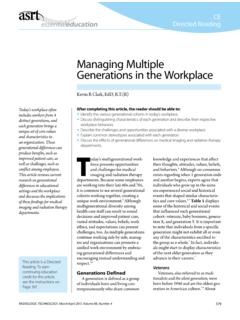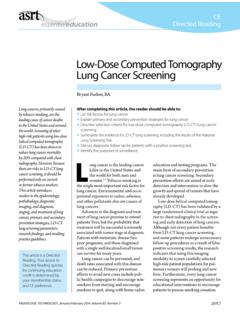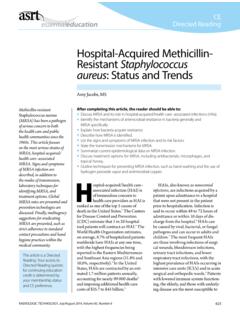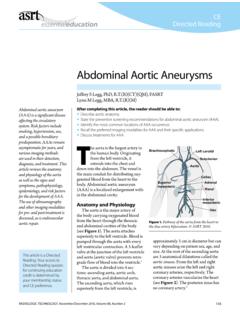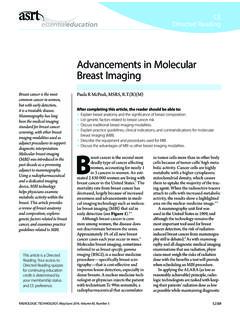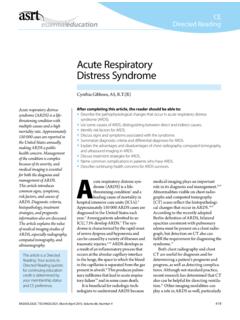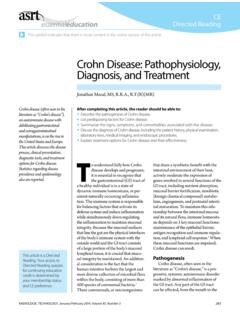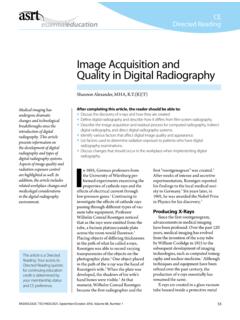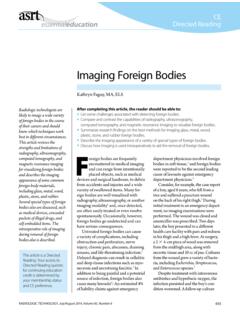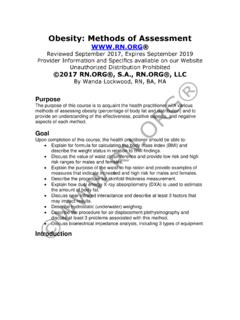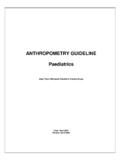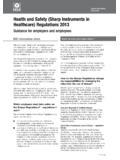Transcription of Obesity in Children and Adolescents: Health Effects …
1 279 CEDirected ReadingThis article is a Directed Reading. Your access to Directed Reading quizzes for continuing education credit is determined by your membership status and CE preference. RADIOLOGIC TECHNOLOGY, January/February 2016, Volume 87, Number 3 Childhood Obesity has become so pervasive that some now describe it as the most com-mon chronic condition of Since the 1980s, the num-ber of obese Children and adolescents in the United States has tripled,2 and near-ly one-third of American Children and adolescents now are classified as either overweight or is a serious Health concern, associated with shorter life spans, higher Health care costs, and complica-tions affecting nearly all of the body s organ Without intervention, obese Children are likely to become obese adults; therefore, it is important for Health care providers to recognize, treat, and prevent Obesity in Children and adolescents before Obesity -related complications become severe and debilitating.
2 Pediatric Obesity is not consistently diagnosed by primary care providers or regularly noted by radiolo-gists on imaging Reversing the tide of overweight and Obesity in Children and adolescents requires the united efforts of Health care profes-sionals, parents, schools, community organizations, public policy makers, and Children . Defining and Measuring ObesityIn adults, overweight and Obesity are determined using body mass index (BMI) categories. BMI is a measurement of body weight relative to height. The formula for calculating BMI is weight (kg)/height (m)2. Converting to more familiar pounds and inches, the formula is weight (lb)/height (in)2 703. After completing this article, the reader should be able to: Explain how overweight and Obesity are measured and categorized. Specify the prevalence of Obesity in Children and adolescents in the United States, internationally, and among certain racial and ethnic groups.
3 State the causes of Obesity . List and describe Health problems associated with Obesity in Children and adolescents. Discuss the Effects of Obesity on Children s and adolescents quality of life and psychological well-being. Describe special considerations and techniques for imaging overweight and obese patients. Summarize key points regarding the prevention and treatment of overweight and Obesity in Children and adolescents. Identify public policy changes that could reduce the Obesity and Obesity are pandemic Health problems, not just among the adult population, but in Children and adolescents as well. This article presents information on the prevalence, causes, prevention, and treatment of overweight and Obesity in young people, with particular focus on the medical and psychological complications associated with the diseases. In addition, the challenges of imaging the obese pediatric population are discussed, and public policy changes that could help reverse Obesity trends in Children and adolescents are introduced.
4 Kathryn Faguy, M A, ELSO besity in Children and Adolescents: Health Effects and Imaging Implications280 CEDirected ReadingRADIOLOGIC TECHNOLOGY, January/February 2016, Volume 87, Number 3 Obesity in Children and Adolescents: Health Effects and Imaging ImplicationsIn addition to computing BMI and comparing the results to a population of Children or adolescents the same age and sex, other simple and inexpensive means of assessing pediatric Obesity are measuring waist cir-cumference, hip circumference, or skinfold thickness and calculating waist/height ratio or waist/hip ratio. Other useful but more costly techniques for assessing the amount of body fat include bioelectrical imped-ance analysis and dual-energy x-ray absorptiometry (DX A).9 Bioelectrical impedance analysis is based on the rate at which a harmless electric current passes through components of the body, such as muscle, bone, fat, and water.
5 It can be used to quickly and noninvasively deter-mine lean and fat body However, readings can The Ta ble presents BMI weight categories for adults 20 years and older. To illustrate these categories, a woman of average height (5 ft, 4 in) who weighs between 108 lb and 144 lb is within the normal BMI range. Weights between 145 lb and 173 lb fall into the overweight BMI category, and weights of 174 lb or more are classified as A lmost 70% of adults 20 years and older in the United States are either overweight or BMI charts are objective and explicitly identify which patients are overweight or obese, so patients and parents can be informed about a problem they might otherwise ignore or deny. For Children and adolescents, weight categories are determined by comparing BMI with Children of the same age and sex. The American Academy of Pediatrics 2007 guidelines state that a patient should be catego-rized as overweight if his or her BMI is between the 85th and 94th percentiles for patients the same sex and age and obese if his or her BMI is in the 95th percen-tile or higher for sex and age (see Figure 1).
6 9 A lthough BMI comparison charts for Children and adolescents are a powerful and easy-to-use tool, they are reportedly underused by nations and organizations, such as the World Health Organization and the International Obesity Task Force, have set different cutoff points for over-weight and Obesity in Children and In the United Kingdom, for example, the cutoff point for pedi-atric overweight under national guidelines is a BMI of 91% or greater for age and sex, and the cutoff for Obesity is a BMI of 98% or greater for age and Pediatric overweight and Obesity is more prevalent under the World Health Organization cutoff points than under some other classification b l e Body Mass Index (BMI) Ranges and Associated Weight Status for Adults 20 Years and Older4-6 BMI (kg/m2)Weight Status obese234567891011121314151617181920kg/m2 kg/m275th90th50th25th10thA10-year-old boy with a BMI of 23 would be in the obese category (95th percentile or greater).
7 A 10-year-old boy with a BMI of 21 would be in the overweight category (85th to less than 95th percentile).A 10-year-old boy with a BMI of 18 would be in the healthy weight category (5th percentile to less than 85th percentile).A 10-year-old boy with a BMI of 13 would be in the underweight category (less than 5th percentile).95th Percentile85th Percentile5th PercentileBody mass index-for-age percentiles:Boys, 2 to 20 yearsFigure 1. This graph illustrates how different body mass index numbers would be classified for a boy aged 10 years. Reprinted from About BMI for Children and adolescents. Centers for Disease Control and Prevention Web site. weight/assessing/bmi/childrens_ Updated July 11, 2014. Accessed October 12, 2014. 281 CEDirected ReadingRADIOLOGIC TECHNOLOGY, January/February 2016, Volume 87, Number 3 FaguyHispanics, and Native ,15 Obesity also is more prevalent in Children and adolescents with lower socioeconomic and Skelton analyzed data from the National Health and Nutrition Examination Survey from the years 1999 to 2012.
8 A total of 26 690 Children and adolescents aged 2 to 19 years participated in the sur-vey and were included in the analysis. The researchers determined that prevalence of all categories of Obesity increased in most groups of study participants between 2009 and 2012, although the increases were not statisti-cally However, Skinner and Skelton found the prevalence of Obesity and overweight increased significantly for certain subgroups in the study, particu-larly Hispanic girls and black Similarly, Ogden and colleagues found no significant changes in the overall prevalence of Obesity in youths between 2003 to 2004 and 2011 to 2012, also based on National Health and Nutrition Examination Survey Nevertheless, they cautioned, Obesity prevalence remains high and thus it is important to continue surveillance. 16 According to National Health and Nutrition Examination Survey data from 2011 to 2012, of Children and adolescents in the United States aged 2 to 19 years were either overweight or obese, and were In addition, of Children and adoles-cents qualified as type 2 obese, a category defined as 120% of the 95th percentile BMI for age and sex or a BMI of 35, whichever is lower.
9 Finally, were clas-sified as type 3 obese, indicating a BMI greater than 140% of the 95th percentile BMI for sex and age or a BMI of 40, whichever is Overweight and Obesity now affect even very young Children , whereas formerly the condition was seen mostly in Children 4 years and Ten percent of infants and one-quarter of toddlers and preschool-aged Children in the United States qualify as overweight or Variations The prevalence of childhood overweight and Obesity varies significantly among the Generally, obe-sity and overweight are more prevalent in the southeast-ern United States, particularly in Mississippi, Georgia, and Tennessee. Conversely, states in the Northwest be affected by how recently a person has eaten, drunk, or hole-body DX A scanning is quick, taking less than 5 minutes, and delivers a low radiation dose of approximately DX A images can be used to calculate percent body fat, fat mass, lean body mass, total tissue mass, and bone mineral content.
10 A limita-tion of DX A scanning is its inability to distinguish vis-ceral fat (ie, fat surrounding the internal organs) from subcutaneous fat. Another potential drawback is that some obese adolescents might be too heav y or too wide for the scanning However, Breihaupt and colleagues found no statistically significant differences between half-body DX A scan results vs full-body results in a study of 58 obese Children and adolescents. They concluded that half-body scanning is a valid alternative for adolescents whose body width exceeded the 60-cm scan area of the DX A equipment used in their imaging techniques can be used to assess body fat, but each is associated with drawbacks. Ultrasonography is a widely available tool but cannot assess the total volume of visceral Computed tomography (CT) accurately depicts visceral fat but entails high levels of radiation exposure and therefore is not justifiable for Obesity assessment in Children and adolescents, particularly considering that multiple assessments might be required over Magnetic resonance (MR)
